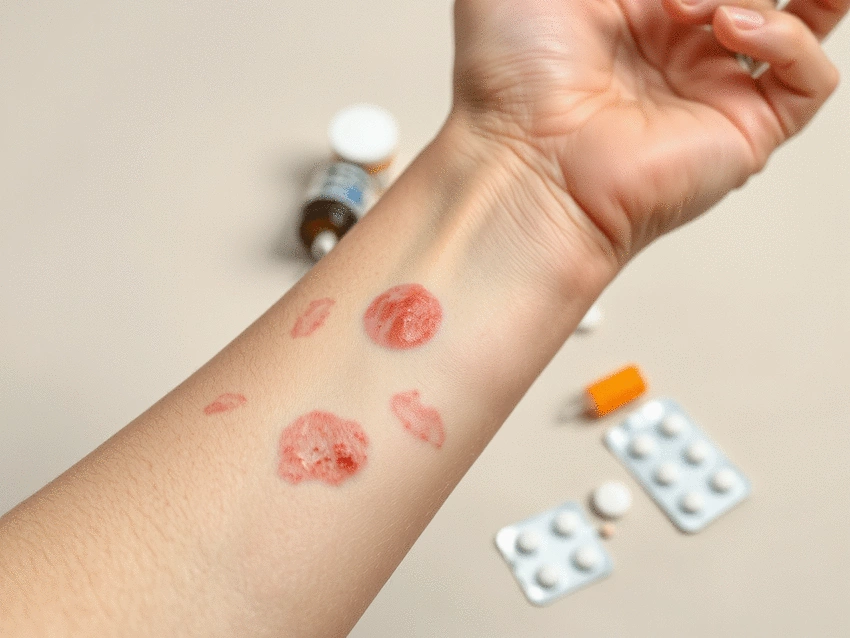Types of Reactions
- • Allergic Reactions
- • Non-Allergic Reactions
- • Idiosyncratic Responses
Have you ever experienced a rash after starting a new medication? If so, you may have encountered a medication-induced rash, a common yet often misunderstood issue. Understanding these reactions can empower you to take control of your skin health.
Understanding the key factors that contribute to medication-induced rashes is crucial for early recognition and effective management. This visual highlights the types of reactions, importance of early identification, and associated risk factors.
Medication-induced rashes can be a puzzling and often distressing issue for many individuals. As someone who has dedicated years to understanding skin health, I’ve seen how easily medication reactions can be overlooked or misdiagnosed. It's essential to recognize that not all rashes are created equal, and being informed about drug reactions can empower you to seek appropriate care.
These rashes can arise from a wide range of medications, including common prescriptions. This overview will help you understand what medication-induced rashes are and why recognizing them early is crucial for your health.
Medication-induced rashes, also known as drug eruptions, are skin reactions triggered by an adverse response to specific medications. These rashes can manifest in various forms, such as hives, rashes, or even blisters. It's fascinating how our bodies react differently to medications, and understanding this variability is vital.
Recognizing the type of rash is the first step in addressing the issue. By being aware of the various forms it can take, you can advocate for your health more effectively!
Identifying medication-induced rashes promptly is crucial for several reasons. Not only can it help prevent further complications, but it can also lead to faster recovery. I often encourage readers to pay close attention to their skin when starting a new medication. For more detailed insights, you can refer to resources like the American Academy of Allergy, Asthma & Immunology.
Ultimately, being educated about drug-induced skin reactions not only helps you manage immediate symptoms but also fosters a proactive approach to your overall skin health. Remember, recognizing the signs of a rash early can make all the difference!
When it comes to medication-induced rashes, knowing the signs and symptoms can be a game-changer. Some reactions may be mild, while others can escalate quickly. It’s essential to familiarize yourself with the spectrum of symptoms to respond appropriately.
Did you know that keeping a detailed medication journal can significantly enhance your ability to manage skin reactions? By documenting the medications you take, along with any skin changes, you can provide your healthcare provider with crucial information that may lead to quicker diagnoses and effective treatments.
Medication-induced rashes, or drug eruptions, are skin reactions caused by an adverse response to specific medications. They can appear as hives, rashes, or blisters.
Early recognition is crucial to prevent severe complications, inform medical decisions for adjusting treatment plans, and contribute to improved overall skin health.
Key risk factors include a prior history of drug allergies, age and skin sensitivity, concurrent use of multiple medications, and existing skin conditions.
Prevention strategies include keeping detailed records of all medications, monitoring your skin’s reaction to new medications, consulting a dermatologist for unusual changes, and staying informed about common drug reactions.
When documenting a reaction, include the medication taken, the date and time of the reaction, a description of the rash or symptoms, and any treatments used along with their effectiveness.
Dermatologists specialize in skin conditions and are ideal for complex rashes. Your primary care provider can manage overall health and refer you to specialists when needed.
Medication-induced rashes can be a perplexing issue, often arising unexpectedly and leading to discomfort. It’s crucial to understand the risk factors associated with these rashes and the strategies for prevention. By recognizing the potential for drug reactions early on, you can take proactive steps to safeguard your skin health.
Some key risk factors include:
Implementing prevention strategies can significantly reduce the risk of developing medication-induced rashes. Always consult with your healthcare provider about any medications you’re prescribed and discuss any personal history of skin reactions. You might be surprised how much this can help!
Being aware of the risk factors can empower you to make informed decisions when starting new medications. For example, if you have a history of skin reactions to specific drugs, it’s vital to communicate this with your doctor. They can explore alternative options that are less likely to cause a rash.
In addition to discussing your history, consider these helpful prevention strategies:
By staying educated and vigilant, you can help ensure that your skin remains healthy and free from unwanted reactions. Always remember that knowledge is power when it comes to managing your skin health!
Keeping a record of any medication-induced rashes or skin reactions is essential. This documentation can be invaluable for your future healthcare providers, ensuring they have all the necessary information to make informed decisions about your treatment. When you document your reactions, include:
Having this information readily available can help streamline your care and guide your healthcare professionals in selecting safer alternatives in the future. It’s all about paving the way for a smoother healthcare experience!
When it comes to managing medication-induced rashes, tapping into the right healthcare resources is critical. Engaging with healthcare professionals who specialize in skin conditions can provide the guidance you need for effective treatment. From my experience, dermatologists are often the best resources for complex skin issues, but your primary care provider is also a valuable ally.
Here are some resources to consider:
Finding expert guidance is not just about immediate relief; it’s also about building a network of support that encourages ongoing skin health.
Understanding the roles of dermatologists and primary care providers can help you navigate your healthcare journey. While dermatologists specialize in skin health and are equipped to handle complex rashes, your primary care provider can offer a holistic view of your overall health and medication management. Each has a unique contribution to your care! You can also find more information on drug-induced skin reactions from clinical journals.
Key differences include:
Recognizing when to seek the right type of care can mean the difference in effectively managing your skin health.
In today’s digital age, there are countless resources available online to help you understand medication-induced rashes better. Trusted medical databases can provide you with detailed information on drug interactions, potential reactions, and treatment options. Here are a few reliable sources:
Using these resources can empower you with knowledge and prepare you for discussions with your healthcare providers. Just remember to verify the credibility of the information you find!
A regular medication review is crucial for anyone taking multiple prescriptions. This process involves evaluating all medications to assess their effectiveness and identify any potential adverse reactions, including skin rashes. I always encourage my readers to have open conversations with their healthcare providers about their current medications.
Here are some benefits of conducting regular medication reviews:
By prioritizing a comprehensive medication review, you’re taking an important step towards minimizing your risk of medication-induced rashes. Your skin will thank you for it!
Here is a quick recap of the important points discussed in the article:


